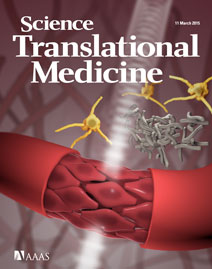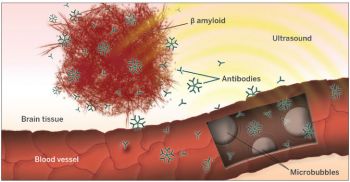A pre-clinical study published this week in Science Translational Medicine suggests that focused ultrasound may hold a key to providing a non-invasive, non-pharmaceutical approach to treating Alzheimer’s disease.

Researchers from the Queensland Brain Institute in Australia demonstrated that combining the injection of microbubbles and applying ultrasound across the brain using a system from Philips Research reduced the number and volume of amyloid plaques in mice genetically altered to model Alzheimer’s disease. In addition, they found that treated mice had improved memory over untreated ones.
Within just a few hours of publication, the research generated interest around the world, with many leading news sources reporting on the study. “Our research was very exploratory and we really didn’t expect to see such a massive effect,” study author Jürgen Götz told Reuters. “I’m really excited by this.”
This important work conducted by Götz and Gerhard Leinenga, neuroscience researchers who are experts in Alzheimer’s disease, corroborates studies done at Sunnybrook Research Institute under the leadership of focused ultrasound pioneer Kullervo Hynynen. Hynynen and his colleagues were the first to publish data suggesting the benefit of focused ultrasound and microbubbles to open the blood-brain barrier (BBB) and reduce the plaque burden in a different Alzheimer’s model. Similarly, Foundation-funded preclinical research at Columbia University by Elisa Konofagou, PhD, safely opened the BBB to treat neurogenerative conditions—including Alzheimer’s.
Foundation Chairman Neal F. Kassell, MD, stated, “These two studies in separate laboratories using different models are the essential predicate for a clinical trial. Combining these data with a successful safety and efficacy study for opening the blood-brain barrier, which is beginning soon at Sunnybrook, could get us there.”
 Although the research is still preliminary, having two validated approaches that use focused ultrasound to eliminate plaques is very promising. “This research makes a wonderful connection between the focused ultrasound community and the neuroscience community that studies Alzheimer’s disease at the most basic cellular level,” said the Foundation’s Chief Scientific Officer Jessica Foley, PhD. “The attention that it is receiving will shed light on the important and immediate advances that are being made to treat a range of brain disorders.”
Although the research is still preliminary, having two validated approaches that use focused ultrasound to eliminate plaques is very promising. “This research makes a wonderful connection between the focused ultrasound community and the neuroscience community that studies Alzheimer’s disease at the most basic cellular level,” said the Foundation’s Chief Scientific Officer Jessica Foley, PhD. “The attention that it is receiving will shed light on the important and immediate advances that are being made to treat a range of brain disorders.”
The Foundation is organizing a steering committee to support additional Alzheimer’s research from preclinical stages to clinical trials.
Read the News Coverage from Science Magazine, The Wall Street Journal, The Guardian, International Business Times, and the Australian.
Read more about Dr. Hynynen’s team’s progress on Alzheimer’s and other diseases.
Image Sources:
(1) STM’s online cover image: Bubbles, Beams, and Microglial Activation. Transient opening of the blood-brain barrier results in activation of microglial cells (yellow), which then start engulfing amyloid plaques (gray) in a mouse model of Alzheimer’s disease. Transient opening of the tight junctions of endothelial cells (red) that comprise the blood-brain barrier was induced by injected microbubbles and an ultrasound beam. From G. Leinenga, J. Götz, Scanning ultrasound removes amyloid-β and restores memory in an Alzheimer’s disease mouse model. Sci. Transl. Med. 7, 278ra33 (2015). Reprinted with permission from AAAS. CONCEPT NICK VALMAS, THE UNIVERSITY OF QUEENSLAND/ILLUSTRATION BY V. ALTOUNIAN/SCIENCE TRANSLATIONAL MEDICINE
(2) Sunnybrook Research Institute
